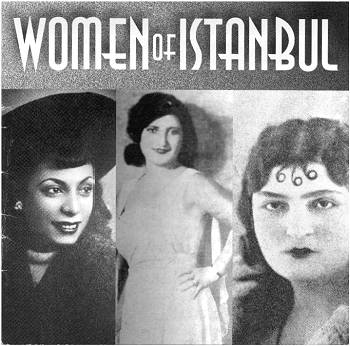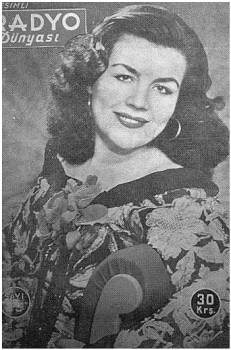This CD comprises recordings of seventeen women singers who had mastered a variety of vocal styles and influenced Istanbul’s musical life from the early Republican period up to the 1970s. The pieces chosen are mostly taken from that repertory of kantos, light art music songs and fantezis, the popular music of the 1925-1950 period. The CD also has the rare distinction of being the first and only recording to show the significant role of women in transmitting and maintaining the Ottoman musical tradition during the early Republican period. The pieces chosen are, in addition, valuable in their own right. The CD mostly contains recordings from the 1927-1940 period. One can find relatively unknown singers, such as Faide Yildiz, Fahriye Hanim, Saadet Hanim, Müserref Hanim, Mahmur Handan Hanim, Küçük Nezihe Uyar, Nedime, and Nezihe, represented on this CD by songs in the more folkloric and lighter sarki styles. One can also find alongside them singers such as Zehra Bilir, Safiye Ayla, Suzan Yakar Rutkay, Roza Eskenazi, Müzeyyen Senar, Hamiyet Yüceses, and Sabite Tur Gülerman, who are still popular today. Faide Yildiz and Zehra Bilir were amongst the most popular folk music singers in this particular period. Many others on the CD sang folk music in addition to being well-known performers in the classical and popular musical styles.
Zehra Bilir was one of the pioneers of the gazino (night club) style. Westerners described her as ‘the Edith Piaf of Turkey’ due to her smooth gazino style. She was one of the most famous singers of folk songs from Anatolia, often appearing in traditional garb and dancing with a handkerchief. One of the most popular entertainers, she appeared frequently on the Radio in Istanbul and Izmir. Track three, ‘Sen bu yaylalara yaylayamazsin’, a Türkü (folk song) in Nikriz makami originally recorded in 1935, demonstrates this style to good effect.
Safiye Ayla was the most highly respected singer of the era. She appeared in virtually all of the well-known concert halls, and appeared on radio and television, and in films. Born in 1907, she took first serious music courses from Eyyubi Mustafa Sunar. She studied makam theory with Yesari Asim Arsoy, She joined the Darü’t-Talim Musiki Ensemble and studied with such notables as Fahri Kopuz, Sadettin Kaynak, Selahattin Pinar, Udi Nevres Bey, Rakim Elkutlu, and Ahmet Irsoy. Sadettin Kaynak, one of the most popular art music composers of the day, composed ‘Saatlerce Basbasa’, a sarki in Hüzzam makami, which Safiye Ayla recorded in 1935 (track 7).
Suzan Yakar Rutkay (known as ‘the Turkish Hedi Lamar’), was born in Istanbul 1912. She was of Armenian ancestry, and began her career in the Halk Film Studio. One of her most famous films was ‘Kenan Mahalle’ which featured a guest appearance by another great singer, Sabite Tur. She is often considered responsible for popularizing rural songs in a distinctly urban musical idiom. She made 34 recordings for HMV and 20 for Columbia, of which ‘Sevda Ziniciri’ (track 10), a türkü (folk song) in Muhayyer makami, is an excellent example.
Roza Eskanazi was born in Istanbul in 1900, but moved to Greece 1920 and lived in Athens most of her life, becoming one of the most famous singers in the Greek rembetika genre. Her earliest recording was made in Thessalonica in 1920. She clearly was not part of the musical scene in Istanbul but an example of her work is included here because she represents an older style of music mostly found in the Greek sections of the city. In 1954, she visited Istanbul, where she probably recorded ‘Eminem’ (track 11) with a group of Turkish musicians.
Müzeyyen
Sennar was born not in Istanbul, but in Bursa 1919,
though, as many other musicians from this city did,
dominated Istanbul’s musical life. She took her
first lessons with Kemençeci Hamiyet Yüceses (b. Istanbul 1914) was her most significant rival. She won several local competitions, including one of the most important, the Kadiköy Vocal Contest. She attended Istanbul Conservatory and studied notation and theory, becoming acquainted with leading contemporary composers such as Kanuni Artaki Candan, Saadettin Kaynak, Selahattin Pinar.
From
around 1930 onwards, she moved steadily into the ranks of
the best-known gazino singers. Her earliest influences
were singers specializing in religious repertories (as
Koranic cantors and so forth), especially Hafiz Burhan.
She became famous for her renderings of the gazel ( vocal
improvisation) style, a well-chosen example of this
concludes this CD (track 14). The gazel section in
Bakmiyor Çesmi Siyah, a sarki (song) in Nihavent makami
recorded in 1946, showcases her powerful voice, her wide
range and her exceptional control. Sehvar Besiroglu |

 Kemal Niyazi Seyhun and Udi
Hayriye Hanim. Later she studied at the famous Üsküdar
Musiki Cemiyeti (music society) and worked with composers
Saadettin Kaynak, Selhattin Pinar, Lemi Atli. She became
an instant star after her first recording at age 16, and
began performing at the Turkish Radio in 1933. From then
on she was, quite simply, the most famous gazino star in
the city, retiring from the Bebek gazinosu only in 1983.
She auditioned for Kanuni Artaki Candan who taught her
several songs and arranged her recordings with Sahibinin
Sesi (HMV). ‘Sigaramin Dumani’ (‘My
cigarette’s smoke’) was recorded on the Odeon
label in 1946; it is a türkü (folk song) in Ussak
makami, with words redolent of the Arabesk style of the
next generation of gazino singers.
Kemal Niyazi Seyhun and Udi
Hayriye Hanim. Later she studied at the famous Üsküdar
Musiki Cemiyeti (music society) and worked with composers
Saadettin Kaynak, Selhattin Pinar, Lemi Atli. She became
an instant star after her first recording at age 16, and
began performing at the Turkish Radio in 1933. From then
on she was, quite simply, the most famous gazino star in
the city, retiring from the Bebek gazinosu only in 1983.
She auditioned for Kanuni Artaki Candan who taught her
several songs and arranged her recordings with Sahibinin
Sesi (HMV). ‘Sigaramin Dumani’ (‘My
cigarette’s smoke’) was recorded on the Odeon
label in 1946; it is a türkü (folk song) in Ussak
makami, with words redolent of the Arabesk style of the
next generation of gazino singers.